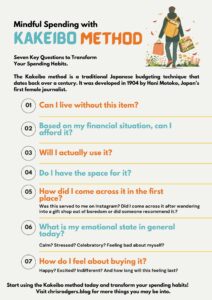Do you have too many things?
You have a minimum of two junk drawers jammed with expired coupons, playing cards, legos, and unclassifiable items you can’t toss in the rubbish because it must fit somewhere. If you are like us you have a basket or two with letters, keys, and indecipherable notes that was intended to be for keys and maybe today’s mail The garage is loaded up with Christmas decorations and lawn ornaments and chairs you’ll never use. You’ve already Marie Kondoed your home, and it’s cluttered again. What happened?
For one, you’re not using the Kakeibo method. Due to flooding, we had to clean out a level of her home and despite trying to be a minimalist it’s near impossible as a family. Many of the things I’ll need to pay money to toss away and wish I hadn’t bought in the first place. Even free items need to be tossed at some point. Just because you have space in your home doesn’t mean something should go there. I love the negative spaces in my home and wish I could plan for it better. These are the spaces where is nothing but floor or empty wall. The homes you love have lot so empty negative space. Just because there is a space to put something doesn’t mean you should. Beyond that though, what if you had a guide to use to filter out unnecessary objects?
What is Kakeibo? Put Kakeibo, pronounced “kah-key-boh,” into Google Translate, and you’ll find it’s a Japanese word meaning “household account book.” But this budgeting method goes beyond Mint R.I.P. Kakeibo injects mindfulness into your spending so you not only get ahead of your finances but also the anxiety that comes with it.
What is Kakeibo?
Kakeibo is a 116-year-old budgeting method using paper ledgers with simple but dedicated inputs. You can purchase notebooks and savings boxesthat do the heavy lifting for you to make saving fun and easy, but the reality is you don’t need to ditch your current budgeting app—you need to ditch your mindset.
The first thing you need to do is to organize your budget into four categories:
- Needs – Items you can’t live without like mortgage, electricity
- Wants – The stuff you enjoy but don’t need (more on this below)
- Unexpected – House, medical, or car repairs
- Culture Stuff – Movies, books, art
Easy Steps to Implement the Kakeibo Method
If you’re into budgeting, chances are you already have similar categories. The Kakeibo Method then asks:
- What money is available?
- What can you save?
- How much are you spending?
- What can you improve?
Focus on Your Wants
The key to improving your budget is managing your wants. How do you limit your wants? You need to make mindful decisions. Similar to having a default filter for food decisions, you need a filter for financial decisions. Easier said than done, but how much of your spending is emotional. For me too much. I’m writing this because I love mindfulness but seem to ignore it when it’s most important. Fortunately, in the 116-year history of this budget method, smart people have broken it down so that even someone with a fistful of dollars at a clearance sale can remember and deploy it.
Key Questions for Mindful Spending
These are the questions CNBC reporter Sarah Harvey credits with changing her spending habits: I created an illustration of the questions below.
- Can I live without this item?
- Based on my financial situation, can I afford it?
- Will I actually use it?
- Do I have the space for it?
- How did I come across it in the first place? (Did I see it in a magazine? Did I come across it after wandering into a gift shop out of boredom?)
- What is my emotional state in general today? (Calm? Stressed? Celebratory? Feeling bad about myself?)
- How do I feel about buying it? (Happy? Excited? Indifferent? And how long will this feeling last?)
Personal Additions to the Filter
You’ll go through all sorts of mental gymnastics. It’s on ‘sale’ or it’s a clearance. Don’t forget it’s been passed over by thousands of other shoppers. Personally, I like to add resale as a final step. I’ve bought plenty of things to use and resell such as gym equipment, landscaping equipment and some clothes.
- Can you resell it for what you pay for it? Yard sales are filled with Pier 1 tchotchkes, but some things will go up in value. Art, some furniture. Quality wins out. If you are a minimalist at heart, you can live without most things. You’ll probably not use it, can’t afford it, and definitely don’t have the space for it. That money would look much better in an IRA.
By adopting the Kakeibo method, you can regain control over your finances and your home. Mindful spending is the key to reducing clutter and anxiety.
See if this 116-year-old Japanese method can transform your life.

Christopher lives in Vermont with his wife, twin boys, border collie and corgi. He has owned a film production company, sold slot machines, and worked for Tony Robbins. He writes in his magical tiny house and sometimes writes in his blog at chrisrodgers.blog
Visit his author’s page.
